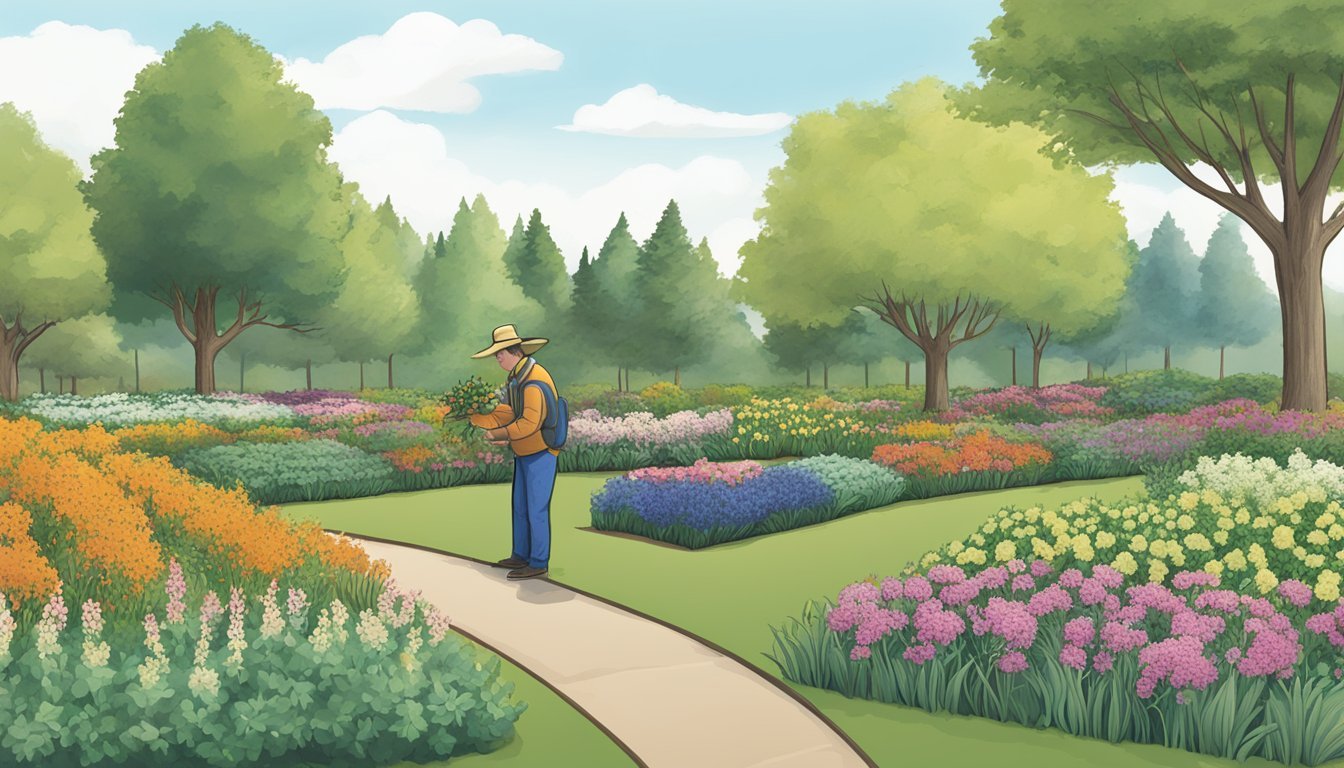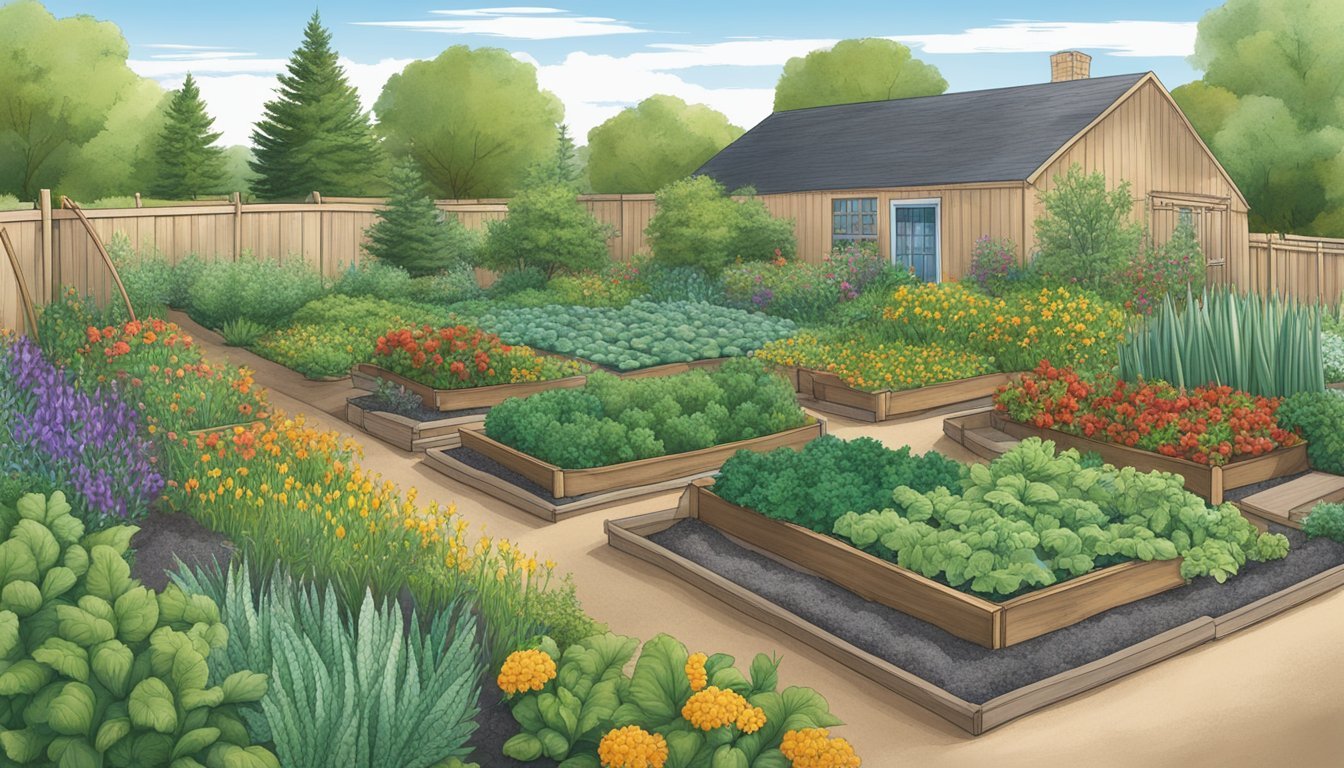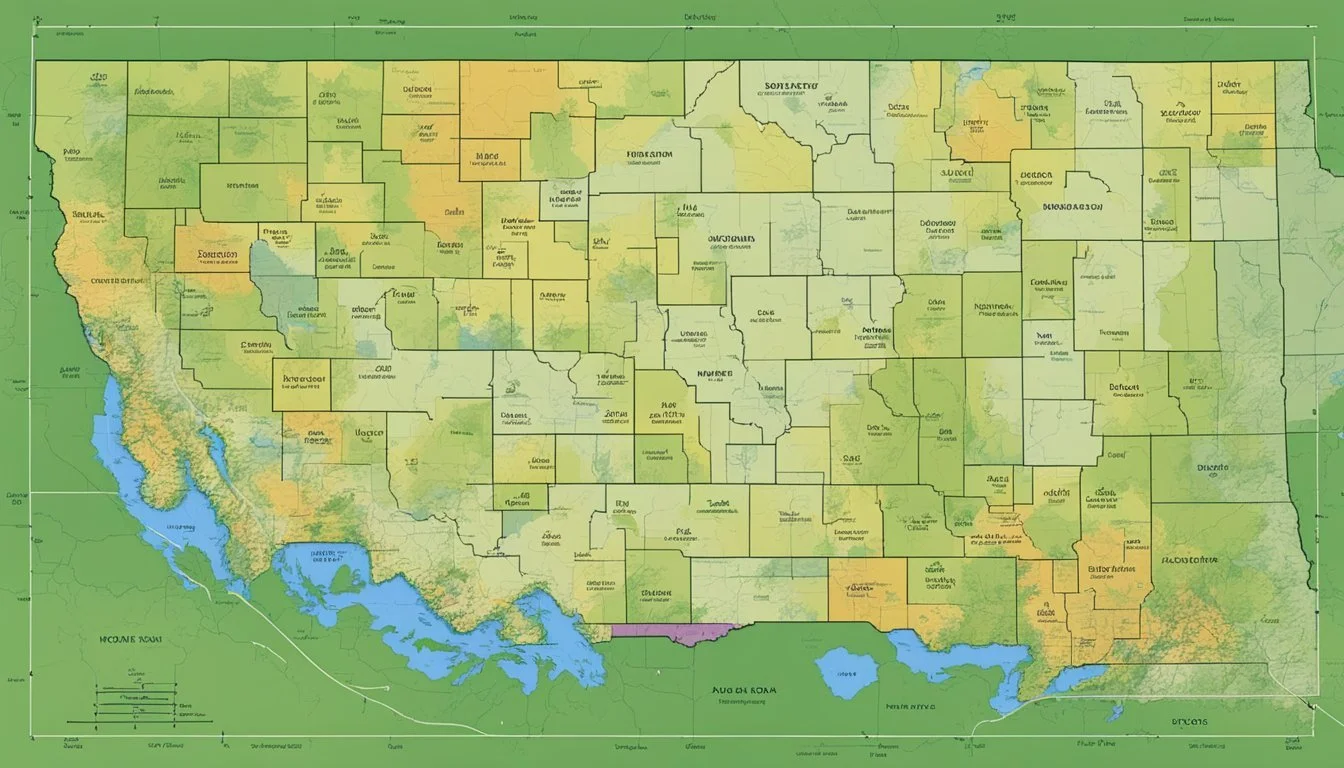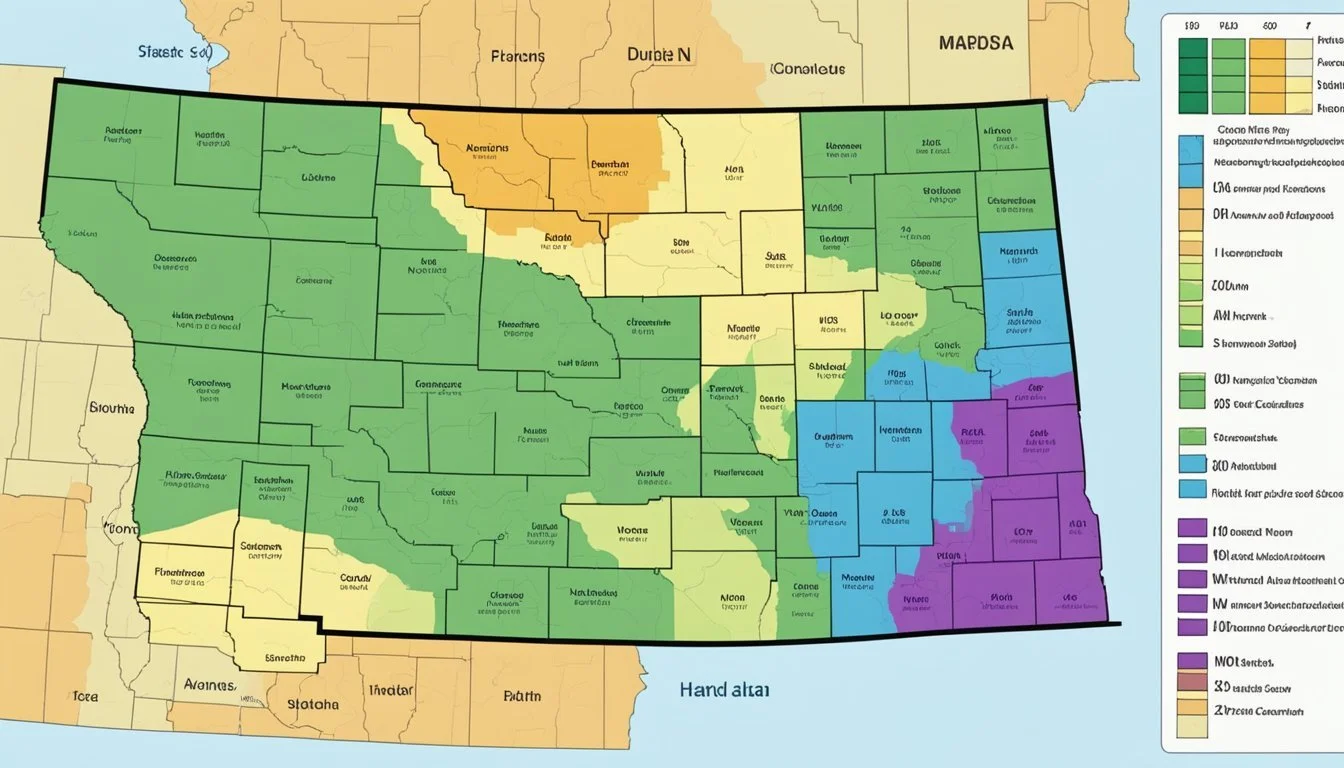USDA Hardiness Zones in North Dakota
A Guide to Planting Success
Understanding the USDA Plant Hardiness Zone Map is essential for gardeners and growers in North Dakota. This tool helps predict which plants are likely to thrive in a specific location. It segments the region into zones based on the average annual extreme minimum winter temperatures. In North Dakota, these zones range from 3a, with minimum temperatures as low as -40°F to -35°F, to 4b, where temperatures dip between -25°F and -20°F.
Updated maps, such as the 2023 USDA Plant Hardiness Zone Map, provide valuable data for selecting appropriate perennials for the climate. The state of North Dakota covers several zones, which indicates a significant variance in climatic conditions across its territory. Gardeners can use this information to assess the winter survival of plant species and make informed decisions about their gardens and landscapes.
Accessing interactive tools like the North Dakota USDA Hardiness Zone Map allows residents to pinpoint their specific zone by entering their zip code. This level of detail simplifies plant selection and supports successful gardening, contributing to North Dakota's rich agricultural and horticultural tradition.
Understanding the USDA Plant Hardiness Zone Map
The USDA Plant Hardiness Zone Map serves as a fundamental tool for gardeners and agricultural planners. It gives a clear depiction of regional climates across the nation to guide the selection and cultivation of plants.
Origin and Purpose of the Plant Hardiness Zone Map
The USDA Plant Hardiness Zone Map originated as an instrument for gardeners and growers to establish which plants are most suited to thrive in a given location. It represents the culmination of climate data, providing a detailed layout of hardiness zones across the United States. Its specific purpose is to categorize regions based on the average annual extreme minimum temperature. The map breaks down the country into zones that are increments of 10°F, with these main zones further divided into sub-zones of 5°F each. This division assists in creating a national standard that aids in plant selection and landscaping decisions based on climatic conditions.
The USDA updates the Plant Hardiness Zone Map when new climate data suggests significant shifts in temperature patterns. These updates guarantee that gardeners, researchers, and producers have the most current information to optimize their plant-related endeavors. The USDA unveils updated Plant Hardiness Zone Map reflects the most recent changes and recommendations for the United States, solidifying its status as a critical resource for successful plant cultivation.
Climate Conditions in North Dakota
Understanding the climate conditions in North Dakota is critical for gardening and agriculture, largely because of the state's significant temperature ranges and its impact on plant hardiness zones.
Average Annual Extreme Minimum Winter Temperature
North Dakota experiences extreme winter temperatures that reflect the overall climate's influence on planting and growth cycles. The average annual extreme minimum winter temperature varies from -30°F to -40°F in the coldest parts of the state, notably in USDA Zone 3a, whereas milder regions like USDA Zone 4b may only dip to around -20°F to -30°F.
Temperature Variations Across the State
Temperature variations are marked across North Dakota, with more dramatic seasonal shifts affecting the northern and central parts of the state. In these areas, winter temperatures are significantly colder, which can limit the selection of plants that can thrive there. In contrast, the southern part of the state, encompassing zones 4a and 4b, generally experiences slightly less severe winter conditions. This variability underscores the necessity for gardeners and farmers to choose plant species adapted to these specific climate and temperature conditions.
USDA Hardiness Zones in Specific North Dakota Locations
The USDA Hardiness Zones provide critical insight into the specific areas within North Dakota, helping gardeners understand which plants are likely to flourish in their locale based on climate conditions.
Bismarck's Gardening Climate
In Bismarck, the capital city of North Dakota, gardeners plant within the confines of Zone 4b, where the minimum temperatures range from -25°F to -20°F. Horticultural enthusiasts in Bismarck can consult the 2023 USDA Plant Hardiness Zone Map for tailored gardening strategies that correspond to the local climatic conditions.
Fargo's Planting Recommendations
Fargo is characterized by a slightly warmer climate falling into Zone 4a, with winter lows averaging between -30°F to -25°F. By referencing Fargo's zone information, residents can select the most suitable perennials for their gardens.
Minot's Growing Conditions
Moving to Minot, the climate falls within Zone 4a, similar to Fargo. This signifies that Minot's conditions are conducive to a range of plant species that are resilient to cold temperatures in this threshold, ensuring a successful growth cycle for appropriately zoned plants.
Other Notable Cities and Their Zones
North Dakota is home to various other cities, each with their distinct hardiness zones:
Grand Forks: Known for being slightly colder, aligns with Zone 4a.
Jamestown: Stays within Zone 4a, offering a similar growing profile to Grand Forks.
Cities like Adams and Bottineau fall snugly into Zone 3b.
Bowman finds itself in Zone 4a.
Cavalier, on the verge of the Canadian border, experiences Zone 4a conditions.
Residents of these cities can identify appropriate plants for their gardens by understanding their respective hardiness zones, ensuring select species are compatible with local winter temperatures.
Selecting Plants for North Dakota Gardens
In North Dakota, gardeners face unique climatic challenges that affect plant selection. The state encompasses USDA Zones 3a to 4b, a factor that's crucial for plant survival and growth.
Selecting Trees and Shrubs
Selecting trees and shrubs for gardens in North Dakota requires understanding of the specific zone conditions. Deciduous trees such as the American Elm and the Quaking Aspen are suitable for the harsh winters, while evergreen conifers like the Black Hills Spruce provide year-round foliage. A visit to a local nursery helps gardeners gain knowledge on the best species that match their garden's hardiness zone. Additionally, reliable online resources such as the North Dakota USDA Plant Hardiness Map provide insight on selecting the right trees and shrubs.
Choosing Flowers and Perennials
When it comes to flowers and perennial plants for North Dakota gardens, it's essential to choose varieties that can withstand below-freezing temperatures. Robust perennials like the Purple Coneflower and the Daylily offer long-lasting blooms and are well-adapted to the state's cold winters. Incorporating these plants not only adds color but also ensures resilience in the garden. Details on plant varieties and their zone requirements can be cross-checked with updated resources, including the interactive North Dakota USDA Plant Hardiness Zone Map.
Gardening Tips for North Dakota Residents
With North Dakota's challenging climate, understanding the soil types specific to the region and implementing meticulous care and maintenance are crucial for a thriving garden.
Understanding Soil Types
Soils in North Dakota can range from heavy clays to light, sandy loams. Gardeners should perform a soil test to determine pH balance and fertility levels. Amending the soil with organic matter can improve soil structure and nutrient availability for plants. In areas with predominantly clay soil, incorporating compost or peat moss can enhance drainage and aeration, essential for root development.
Importance of Care and Maintenance
Regular maintenance is vital to gardening success in North Dakota's hardiness zones. Gardeners must manage watering, ensuring consistent moisture levels without overwatering, which can lead to root rot in cooler climates. Protecting plants from harsh winter temperatures and wind is also critical. This might involve mulching to regulate soil temperature and shield plants from freeze-thaw cycles. Pruning damaged or diseased limbs from shrubs and trees each season promotes healthy growth and prevents the spread of pests and diseases.
Agricultural Insights for North Dakota
North Dakota's agriculture is significantly influenced by the state's hardiness zones, with wheat as a leading crop. The hardiness zones guide farmers in crop selection, ensuring sustainable and productive agriculture.
Wheat Cultivation and Hardiness
Wheat thrives in North Dakota, notably in areas classified within USDA Zones 3a to 4b. The state's climate offers optimal growing conditions for spring wheat, especially durum, due to the cold tolerance of these wheat varieties. Winter wheat, on the other hand, requires specific planting zones that provide the necessary cold period for vernalization—this is where precise knowledge of local hardiness zones is invaluable.
Spring Wheat: Optimal in Zones 3a - 4b
Winter Wheat: Planting predicated on adequate winter hardiness
The Influence of Growing Zones on Crop Selection
North Dakota's growing zones play a pivotal role in dictating the assortment of crops that farmers can sustainably cultivate. Utilizing the 2023 USDA Plant Hardiness Zone Map, agriculturalists determine which plants are most likely to succeed. For instance, the shift in planting zones towards the north, as noted by climate change observations, has expanded the range where certain varieties can be planted, signaling potential for diversification in the future.
USDA Zones 3a - 4b: Current standard for crop selection
Climate Change Impact: Northward shift influencing planting choices
hardiness zones and growing zones are integral in regional agricultural planning, ensuring that farmers in North Dakota make informed decisions for their crops, particularly wheat.
Navigating Localized Hardiness Zones
Understanding the specific hardiness zones within North Dakota is crucial for gardeners and growers, as these zones can dramatically affect the survival and flourishing of plants. The United States Department of Agriculture (USDA) provides a comprehensive guide to these zones, which are delineated by zip code to offer the most relevant planting information.
Using Zip Code for Precise Planting Information
Gardeners and growers looking for accurate planting guidance can utilize their zip code to pinpoint the exact USDA Plant Hardiness Zone for their area. This precision is beneficial for towns like Ross, McClusky, and LaMoure, where local climate conditions may vary significantly. For instance:
Ross, ND (zip code 58776), typically falls into Zone 4a. This indicates minimum temperatures ranging from -30 to -25 degrees Fahrenheit.
Moving on to McClusky, ND (zip code 58463), one would find themselves in Zone 3b, where the thermometer can plunge to -35 to -30 degrees Fahrenheit during winter.
Down in LaMoure, ND (zip code 58458), the zone shifts to 4b, suggesting slightly warmer tolerances, with extreme minimums averaging -25 to -20 degrees Fahrenheit.
By using zip code-specific data, residents can make informed decisions about which plants are most likely to endure the winter temperatures in their immediate surroundings.
Supporting North Dakota's Planting Community
In North Dakota, the planting community is bolstered by resources that help gardeners and nurseries navigate the challenges of the climate. The state spans several USDA Hardiness Zones, which are essential for understanding plant survivability.
Resources for Gardeners and Nurseries
USDA Plant Hardiness Zone Map
It is invaluable for both novice and experienced gardeners as well as nurseries in identifying the right plants for their region. The map delineates regions by their average annual extreme minimum winter temperature, arranged into 10-degree F zones. North Dakota's zones range from 3a through 4b, which means plant selection can vary significantly within the state. Information on zones is accessible through the USDA Plant Hardiness Zone Map.
Local Interactive Maps
Nurseries and gardeners can utilize an Interactive North Dakota USDA Plant Hardiness Zone Map. This tool assists in making informed decisions about what will thrive in their specific locale within North Dakota.
Educational Articles and Guides
Part of a gardener's and nursery's toolbox includes educational content. For instance, articles discussing hardiness zones and ecoregions offer nuanced insights beyond just temperature minimums, fostering a deeper understanding of the local ecosystem.
Government Resources
The North Dakota Department of Agriculture provides a range of maps and resources including the Plant Hardiness Map, which is beneficial for both personal gardeners and commercial nurseries. They also offer information on pest control and weed seed-free forage, which can be found at the North Dakota Department of Agriculture's resource page.
Through these resources, individuals and businesses in North Dakota's planting community can make educated choices about the plants they grow, which can lead to more successful gardening and nursery operations in the region.
Plant Hardiness and Conservation in North Dakota
Understanding plant hardiness is crucial for conservation in North Dakota, as it informs which plants are most viable across different regions and climates.
The Role of Hardiness Zones in Conservation Efforts
The USDA Plant Hardiness Zone Map is a vital tool utilized by horticulturists and conservationists in North Dakota. This interactive map guides them in determining which plants are best suited for the state's varying climatic conditions, thus ensuring successful growth and preservation of native species. North Dakota spans from USDA Zone 3a to USDA Zone 4b, suggesting a range of extreme minimum temperatures from -40 to -20 degrees Fahrenheit.
Conservation efforts in the state often hinge on these zones to foster plant species that can thrive locally. The hardiness map, which reflects average annual minimal winter temperatures, provides a foundational dataset that helps align conservation practices with the region's climate. For instance, conservationists might prioritize plants that are indigenous to Zone 3a in the northern part of North Dakota due to their resilience to colder temperatures.
Ultimately, by employing the USDA map as a key resource, conservationists in North Dakota can make informed choices. These decisions support local ecosystems by advocating for plant species that not only endure but also fortify the natural region against environmental stressors.
Hardiness Zone Variability and Adaptation
In North Dakota, the shift in USDA Hardiness Zones impacts the practices of gardeners and agricultural producers. With temperatures warming, zones have nudged northward, necessitating adaptations in planting strategies.
Adapting Gardening Practices to Zone Shifts
Gardeners and farmers in North Dakota are facing a new reality as USDA Hardiness Zones evolve. Historically, the state spanned zones 3a to 4b, but recent data indicates a trend toward warmer zones. This shift does not just alter the planting timelines; it also expands the range of plants that can potentially thrive.
Key Actions for Adaptation:
Monitoring changes: Staying informed about the latest hardiness zone map enables gardeners to adjust their practices accordingly.
Amending soils: Altering soil composition can help in accommodating plants suited to the new zones.
Adjusting planting schedules: Given the zone shifts, planting dates may need to be reconsidered to align with the new climate patterns.
By effectively responding to zone shifts, North Dakota’s planting community can adapt to these changes, accommodating a broader variety of plant species and optimizing growth cycles for long-term success in a changing climate.
City-Specific Planting Guides
This section provides tailored planting guides for cities within North Dakota, detailing their respective USDA Hardiness Zones and optimal planting conditions.
Abercrombie to Ashley
Abercrombie: Gardeners in Abercrombie adapt to the city's USDA Hardiness Zone 4a, where the minimum temperature can drop to -30°F. A selection of hearty perennials is best suited for this climate.
Alamo: Residing in Zone 3b, Alamo's gardeners prepare for even colder temperatures reaching -35°F, opting for robust shrubs and trees.
Alexander: With similar conditions to Abercrombie, Zone 4a in Alexander supports a variety of fruit trees acclimated to its climate.
Ashley: Enduring temperatures as low as -30°F in Zone 4a, Ashley's planting season includes cold-resistant vegetables and ornamental grasses.
The remaining cities within this subsection, such as Alice, Almont, and Aneta, also fall within Zones 3b to 4a. Residents are encouraged to plant durable species like conifers and native grasses that withstand harsh winters.
Auburn to Carrington
Auburn: Auburn's gardens flourish under Zone 4a, where plants must endure minimum temperatures of -30°F. It is preferable to grow wind-tolerant and drought-resistant varieties due to the open, exposed terrain.
Carrington: With conditions akin to Zone 4a, Carrington supports the cultivation of hardy fruits like apples and resilient ornamentals that can survive the chilly winters.
The cities from Auburn to Carrington share a common challenge of cold winters and short growing seasons. Emphasis is on selecting species such as junipers and perennial flowers that are capable of surviving in their respective hardiness zones.
Extended Plant Hardiness Resources
The United States Department of Agriculture (USDA) provides comprehensive maps and data serving as pivotal resources for gardeners and agriculturists in North Dakota. These materials are essential for making informed decisions about plant selection and landscaping within the region's distinct hardiness zones.
Further Reading and Learning
To gain a deeper understanding of plant hardiness zones, especially in the context of North Dakota, gardeners and horticulturalists can explore the detailed North Dakota Interactive USDA Plant Hardiness Zone Map. This map visualizes various zones and their associated temperature ranges, aiding in plant selection for local climates.
The USDA Plant Hardiness Zone Map provides a national overview of the zones. It is periodically updated to reflect climatic changes, with the last update noted in November 2023.
Additional resources and maps can be found through the North Dakota Department of Agriculture, which includes the current USDA Plant Hardiness Zone Map that is widely accepted as the standard for local gardeners and growers determining suitable plants for their area.
Lastly, Gardening Know How offers an educational platform that discusses the USDA's methodology behind the map and its implications for plant distribution and gardening practices in North Dakota.
Frequently Asked Questions
Understanding the USDA hardiness zones is crucial for successful gardening and agriculture in North Dakota. These zones help determine the best plants for a given location's climate, especially the coldest temperatures a region might face.
How can I find the USDA hardiness zone for a specific location in North Dakota?
One can identify the USDA hardiness zone for a specific location in North Dakota by utilizing the 2023 USDA Plant Hardiness Zone Map.
Where can I view a map of North Dakota's hardiness zones for gardening purposes?
A map of North Dakota's hardiness zones tailored for gardening can be found on the Plantmaps website, which shows the zones ranging from 3a to 4b.
What are the main differences between the hardiness zones within North Dakota?
The differences between the hardiness zones in North Dakota reflect variations in the average annual extreme minimum winter temperatures, which inform gardening and planting strategies.
In terms of plant hardiness zones, where does Fargo, ND, fall?
Fargo, ND, is typically classified in zone 4b on the USDA Plant Hardiness Zone Map, indicating its suitability for plants tolerant to minimum winter temperatures of -25 to -20°F.
Which USDA hardiness zone encompasses Bismarck, North Dakota?
Bismarck, North Dakota, generally falls under USDA hardiness zone 4a, with an average annual extreme minimum temperature of -30 to -25°F.
How do the hardiness zones in Williston, ND, compare to those in Minot, ND?
Williston and Minot, ND, both experience cold winters but may lie in slightly different hardiness zones, with some areas surrounding Minot possibly being slightly warmer than Williston.












